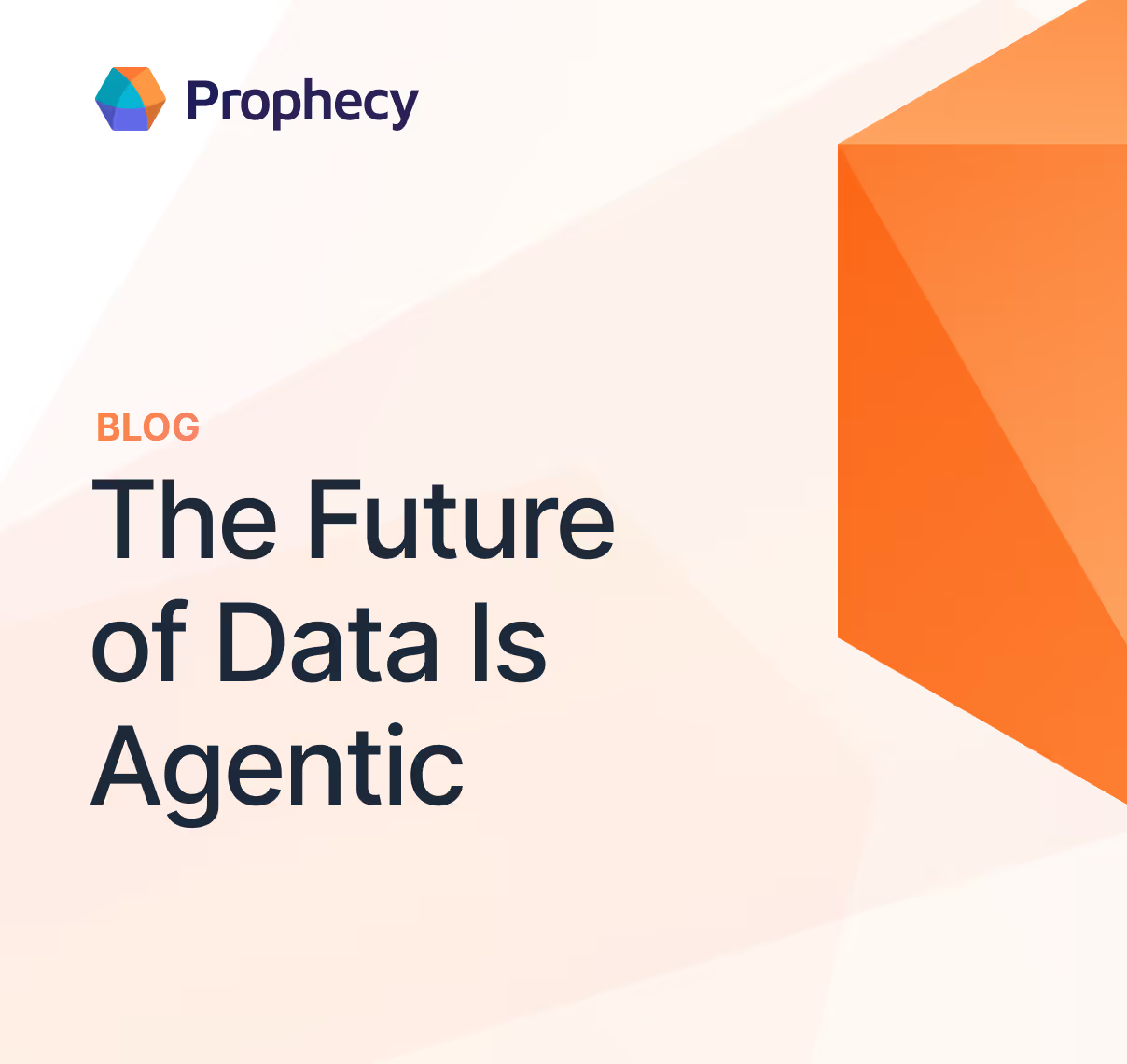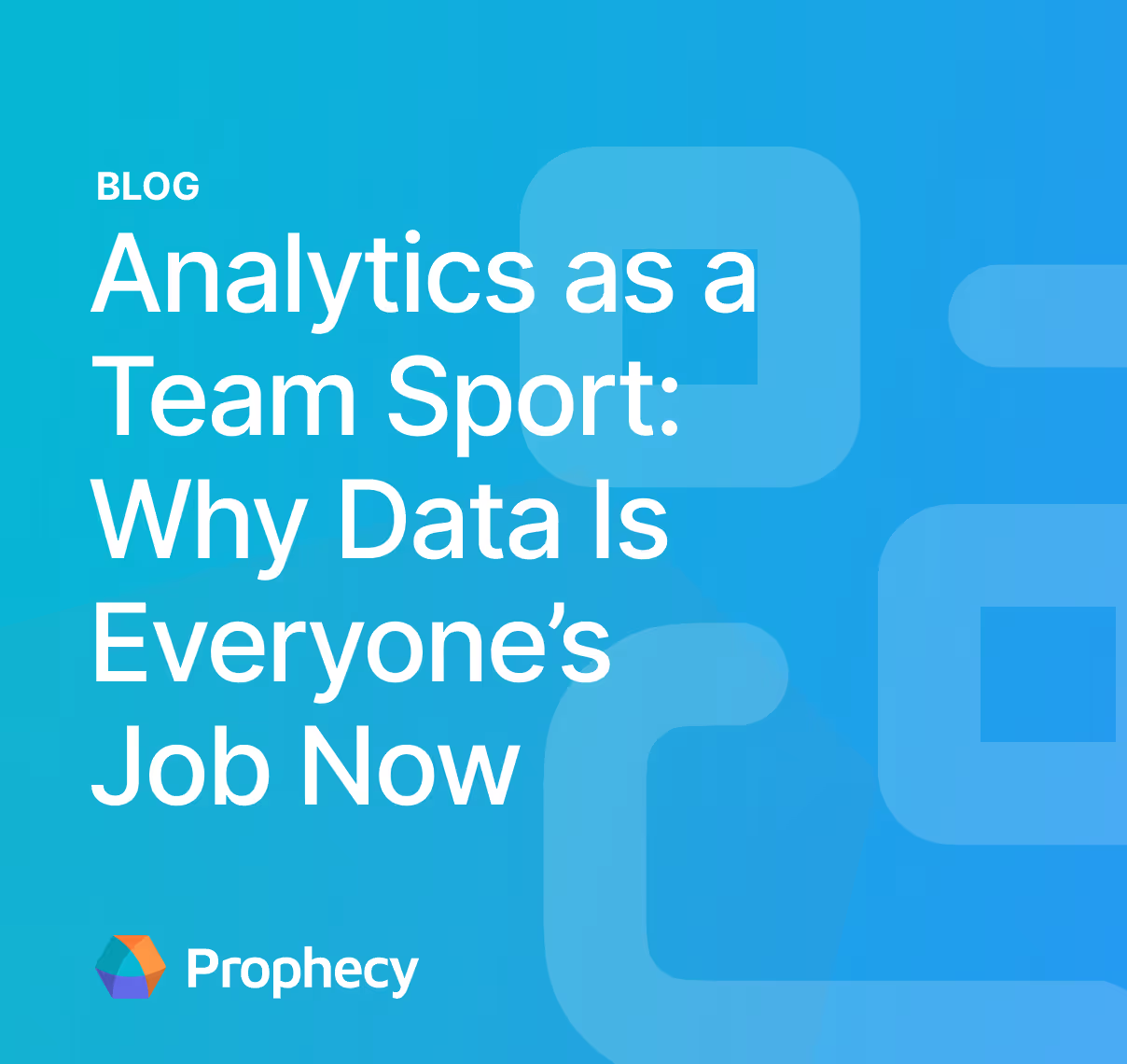How Forward-Thinking Platform Leaders Build Data Integrity That Prevents Quality Chaos
Discover how platform leaders build data integrity that scales across teams without creating bottlenecks or sacrificing self-service innovation.
In the race to deploy AI and advanced analytics, organizations often overlook a fundamental truth: even the most sophisticated algorithms can't overcome poor data integrity. While executives demand faster insights and broader data access, platform leaders find themselves caught between delivering self-service capabilities and maintaining the data quality standards that prevent catastrophic business decisions.
The challenge requires frameworks that establish accountability across teams while enabling the agility modern businesses demand. This paradox intensifies as organizations scale their data operations—every new data source, user, and use case creates potential integrity gaps that can cascade into enterprise-wide quality failures.
In this article, we explore how platform leaders can build enterprise-wide data integrity strategies that prevent the quality failures, trust erosion, and operational chaos that undermine data-driven transformation initiatives.
What is data integrity?
Data integrity is the maintenance of data accuracy, consistency, and reliability throughout its entire lifecycle, from initial collection through processing, storage, and consumption. It encompasses both the technical safeguards that prevent data corruption and the organizational processes that ensure information remains trustworthy as it flows through different systems and teams.
In modern enterprise environments, data integrity extends beyond traditional database constraints to encompass the complex workflows, transformations, and integrations that characterize cloud-native data platforms.
As organizations migrate from monolithic systems to distributed architectures with multiple data sources, processing engines, and varying consumption patterns, maintaining integrity requires coordinated strategies that span the entire data lifecycle, rather than relying on point-in-time validation checks.
Data integrity vs. data quality vs. data reliability
While these terms are often used interchangeably, each addresses distinct aspects of trustworthy data management:
- Data integrity: The structural soundness and consistency of data across systems and time. Data integrity focuses on preventing unauthorized changes, maintaining referential relationships, and ensuring data remains uncorrupted during storage and transmission.
- Data quality: The fitness of data for its intended use, measuring attributes like accuracy, completeness, timeliness, and validity. Data quality evaluates whether information correctly represents the real-world entities or events it's supposed to describe.
- Data reliability: The consistency and dependability of data systems and processes over time. Data reliability ensures that data collection, processing, and delivery mechanisms function predictably and produce consistent results under varying conditions, often achieved through practices like systematic data auditing.
Organizations often focus heavily on data quality metrics while neglecting the foundational integrity that makes quality measurement possible. Similarly, reliability investments in infrastructure mean little if the data flowing through those systems lacks fundamental integrity safeguards.
This interconnected relationship means that platform leaders must address all three dimensions simultaneously. Strong data integrity provides the foundation for meaningful quality assessment, while reliable systems ensure that integrity and quality standards can be consistently maintained across the enterprise.
Types of data integrity
Data integrity manifests through several distinct but interconnected dimensions that platform leaders must address:
- Physical integrity: The protection of data from corruption during storage and transmission across systems. Physical integrity safeguards ensure that data remains unchanged during backup operations, network transfers, and transitions between storage media.
- Logical integrity: The maintenance of data accuracy and consistency according to business rules and constraints. Logical integrity ensures that data values make sense within their business context and conform to predefined validation rules.
- Entity integrity: The requirement that each record maintains a unique identifier and cannot contain null values in primary key fields. Entity integrity prevents duplicate records and ensures that each data item can be uniquely identified and referenced.
- Referential integrity: The consistency of relationships between related data across different tables or datasets. Referential integrity ensures that foreign key relationships remain valid and that referenced records exist.
- Domain integrity: The enforcement of valid values for specific data fields based on defined constraints, ranges, or acceptable formats. Domain integrity prevents invalid data entry and maintains consistency in how information is represented.
These integrity types collaborate to establish a comprehensive framework for ensuring data trustworthiness. Platform leaders who focus on only one type, such as implementing strong authentication for physical integrity while ignoring logical validation rules, create incomplete protection that allows quality issues to emerge through other pathways.
Benefits of data integrity to platform leaders
Data integrity has evolved from a technical requirement to a strategic imperative as organizations increasingly rely on data-driven decision-making. Forward-thinking platform leaders prioritize data integrity because it delivers critical business benefits:
- Prevents catastrophic business decisions: Poor data integrity drives organizations toward fundamentally flawed strategic choices. When executives base major decisions on corrupted, inconsistent, or unreliable data, the consequences cascade through every aspect of business operations. A single integrity failure in customer data can lead to misguided product development, ineffective marketing campaigns, and resource allocation decisions that miss market opportunities by months or years.
- Builds trust in self-service analytics: The democratization of data access through self-service analytics creates enormous value but introduces integrity risks that traditional centralized approaches never faced. Without proper integrity safeguards, teams have access to data but no reliable way to ensure they're working with accurate, consistent information. Different teams analyzing the same business questions reach contradictory conclusions, undermining confidence in data-driven insights.
- Enables AI and advanced analytics initiatives: Modern AI systems amplify both the value of high-integrity data and the risks of poor-quality information. Machine learning algorithms don't just process bad data—they learn from it, embedding integrity issues into automated decisions that affect thousands or millions of business interactions. The garbage-in, garbage-out principle becomes exponentially more dangerous when garbage gets processed by intelligent systems that make autonomous decisions.
- Meets regulatory compliance requirements: Data integrity serves as the foundation for virtually every regulatory framework affecting modern businesses. Whether organizations operate under GDPR, SOX, HIPAA, or industry-specific regulations, compliance depends on demonstrating that data remains accurate, complete, and secure throughout its lifecycle. Regulatory auditors increasingly focus on data lineage, change tracking, and integrity validation processes rather than just security controls.
- Optimizes operational efficiency across teams: When data integrity frameworks function effectively, they eliminate the manual validation work that consumes significant time across business and technical teams. Instead of spending hours verifying that numbers match between systems or investigating discrepancies in reports, teams can focus on analysis and decision-making activities that drive business value.
How to solve the data integrity challenge in data product development
Enterprise data integrity faces a fundamental paradox: the more you democratize data access to drive business value, the more you risk undermining the very integrity standards that make data trustworthy.
Platform leaders find themselves caught between two failure modes—maintaining such tight control that business innovation stalls, or enabling such broad access that data chaos undermines decision-making confidence.
Breaking free from this paradox requires platform leaders to rethink traditional approaches that treat governance and agility as opposing forces. Let’s see how.
Automate governance workflows to eliminate approval bottlenecks
Traditional data integrity approaches create exactly the bottleneck scenario that frustrates business teams and limits organizational agility. When every data integrity rule requires central IT approval and every schema change needs committee review, business teams either wait weeks for critical data or circumvent governance entirely to meet deadlines.
Transform these manual approval processes into automated workflow systems that can evaluate most governance decisions without human intervention. Modern platforms can assess schema changes for downstream impact, validate business rule modifications against existing constraints, and approve routine quality updates based on predefined criteria—all while maintaining audit trails for compliance.
Build domain-driven accountability frameworks where business teams own data accuracy within their areas of expertise while platform teams provide the infrastructure for consistent integrity enforcement. This approach distributes the governance workload while maintaining enterprise standards, preventing both bottlenecks and chaos.
Implement graduated enforcement that aligns with integrity requirements and business impact. Minor formatting inconsistencies may trigger automatic correction, while significant business rule violations halt processing until the underlying issues are resolved by human review. This proportional response maintains quality without creating unnecessary friction for low-risk operations.
Create exception handling processes that escalate only the decisions that truly require human judgment while automating everything else. When governance workflows can handle 80% of integrity decisions automatically, the remaining 20% receive appropriate attention without creating systematic delays.
The goal isn't perfect data—it's data that's good enough for its intended use, delivered fast enough to drive business decisions. When integrity frameworks align with business velocity requirements, governance becomes an enabler rather than an obstacle.
Embed quality intelligence directly into self-service tools
While automated governance workflows prevent administrative bottlenecks, you also need to address quality issues at the point where business users create data products. When business users gain access to data creation tools without embedded quality safeguards, organizations quickly discover that different teams analyzing the same questions reach contradictory conclusions—a scenario that undermines confidence in data-driven decision-making.
This challenge requires moving beyond governance processes to embed validation intelligence directly into modern self-service tools themselves. When business users drag and drop data elements or write SQL queries, the platform should automatically apply referential integrity checks, validate business rules, and ensure schema compliance without requiring technical expertise or manual approval steps.
Create shared semantic layers that ensure consistent definitions across all data products, regardless of who creates them. When different teams analyze customer lifetime value or revenue recognition, they should automatically inherit compatible calculations rather than inventing their own approaches that produce conflicting results.
Build real-time feedback mechanisms that guide business users toward quality practices during data product creation rather than catching errors after deployment. Effective self-service platforms provide contextual guidance about data relationships, suggest appropriate validation rules, and warn users about potential quality issues before they become problems.
Implement collaborative validation frameworks that allow business experts to define quality rules in business terms while technical teams ensure those rules translate into effective technical controls. This collaboration ensures that embedded intelligence reflects actual business requirements rather than generic technical constraints.
Unify fragmented systems under consistent standards
Enterprise data environments often evolve into sprawling ecosystems where incompatible data structures proliferate across the organization, making integration and analysis increasingly difficult. Each system maintains its own integrity standards, validation rules, and quality processes, creating exponential complexity that exhausts technical teams.
This fragmentation doesn't just create technical debt—it undermines business agility by making cross-functional analysis nearly impossible. When customer data in marketing systems can't be easily combined with transaction data in financial systems, organizations lose the holistic view necessary for strategic decision-making.
Establish unified metadata frameworks that provide consistent data definitions and integrity requirements across all enterprise systems. Rather than forcing immediate migration to centralized platforms, create interoperability layers that allow existing systems to participate in enterprise-wide quality standards while maintaining their specialized capabilities.
Implement schema governance that strikes a balance between stability and evolution, allowing for structural changes that support business needs while maintaining compatibility across dependent systems. Version control practices for schema evolution prevent the coordination overhead that typically accompanies structural changes while ensuring that modifications don't break existing analyses.
Deploy automated testing that validates cross-system integrity continuously rather than waiting for integration projects to discover compatibility issues. This testing should verify both technical compatibility and business rule consistency, ensuring that data relationships remain logical as systems evolve independently.
Build data contracts that bridge business and technical accountability
The gap between business data requirements and technical implementation creates persistent integrity issues that manifest as quality problems downstream. Business teams understand what data should represent but struggle to communicate validation requirements effectively, while technical teams implement systems that meet functional specifications but miss crucial business constraints.
Data contracts formalize these relationships by creating explicit agreements about quality expectations, delivery requirements, and change management processes. Unlike traditional technical specifications, these contracts focus on business outcomes rather than implementation details, thereby creating shared accountability for maintaining integrity.
Design contracts that specify quality requirements in business terms while automatically translating them into technical validation rules. When business teams define customer data requirements, the platform should generate appropriate referential integrity checks, value range validations, and consistency tests without requiring manual coding.
Implement contract testing that continuously validates whether data products meet their specified business requirements rather than just technical compliance. This testing should catch logical inconsistencies, business rule violations, and semantic drift before they affect downstream analyses or automated decision-making processes.
Create evolution frameworks that enable producer-consumer relationships to adapt to changing business requirements while maintaining clear documentation and stakeholder agreement. Contract modifications should trigger impact assessments that help all affected teams understand and prepare for changes that might affect their data products.
Deploy monitoring that detects business impact, not just technical failures
Traditional data quality monitoring focuses on technical metrics that don't directly translate to business consequences, creating alert fatigue while missing the integrity issues that actually affect decision-making. When monitoring systems generate hundreds of warnings about minor formatting inconsistencies while missing logical errors that corrupt financial calculations, they become obstacles rather than aids to quality management.
Transform monitoring from technical compliance checking to business impact assessment by connecting quality metrics to specific decision-making processes. Instead of generic data quality scores, track metrics like "revenue calculation accuracy" or "customer segmentation consistency" that directly relate to business outcomes.
Implement anomaly detection that identifies unusual patterns in business metrics, rather than just technical indicators, to catch integrity degradation before it affects operational results. Machine learning-based monitoring can identify subtle quality trends that human analysis might miss, while reducing false positive alerts that can lead to monitoring fatigue.
Build lineage tracking that follows data quality issues through their business impact rather than just technical propagation. When integrity problems occur, teams need to understand which analyses, reports, and automated decisions might be affected rather than just which systems experienced technical errors.
Create feedback loops that connect quality issues to the specific teams and processes responsible for resolution, ensuring that integrity problems receive attention from people positioned to address root causes rather than just symptoms. Effective monitoring becomes a collaborative tool that improves quality over time.
Create accountability cultures that reward integrity stewardship
Technical controls can enforce data integrity rules, but sustainable quality requires organizational cultures that make integrity stewardship a shared responsibility rather than an afterthought. This cultural transformation requires aligning individual and team incentives with enterprise data quality outcomes while making quality contributions visible and rewarding.
Incorporate data integrity metrics into performance evaluations for teams that produce or consume data, focusing on business impact rather than technical compliance. Quality measurements should be connected to decision-making effectiveness, analytical accuracy, and downstream system reliability, rather than abstract quality scores that don't motivate behavior change.
Establish recognition programs that celebrate teams and individuals who contribute to enterprise data integrity through improved processes, innovative quality solutions, or exceptional stewardship of critical data assets.
Public recognition provides positive reinforcement for behaviors that benefit organization-wide data quality, while fostering communities of practice centered on integrity and excellence.
Design cost allocation models that connect the business value of high-quality data to the investments required for integrity maintenance. Teams that benefit from reliable, accurate data should understand and contribute to the costs of maintaining that quality, creating sustainable funding models for integrity initiatives while building stakeholder investment in quality outcomes.
Build collaborative learning frameworks that enable teams to share quality improvement strategies and learn from each other's experiences with integrity challenges. Cross-functional knowledge sharing accelerates quality improvement while building organizational capabilities for ongoing integrity stewardship that withstands personnel changes and organizational restructuring, and enhances data literacy.
End the integrity-democratization tradeoff
Data integrity strategy represents the foundation that enables every other data initiative, from basic analytics to advanced AI deployments. Platform leaders who master enterprise-wide integrity frameworks unlock the business agility that comes from trusted, accessible data, while avoiding the chaos that undermines confidence in data-driven decision-making.
The organizations that succeed in this balance don't choose between governance and innovation—they create platforms that embed governance directly into the data development process. Here's how Prophecy enables this transformation:
- Governed self-service development that embeds validation rules directly into visual pipeline creation, ensuring quality standards are maintained even when business users build their own data products
- Automated schema evolution that manages change across enterprise data environments without breaking downstream dependencies, eliminating the coordination overhead that typically slows schema governance
- Real-time data lineage tracking that provides instant visibility into how changes propagate through complex data environments, enabling rapid root cause analysis when integrity issues occur
- Collaborative validation frameworks that bridge business and technical teams around shared quality objectives, eliminating the translation barriers that create integrity gaps between requirements and implementation
- Enterprise-grade observability that monitors both technical compliance and business impact of data quality initiatives, providing the metrics needed to demonstrate ROI while maintaining operational excellence
To escape the productivity drain of manual data validation while maintaining the governance standards your business demands, explore Designing a Copilot for Data Transformation to build enterprise-wide integrity frameworks that scale with your ambitions.
Ready to give Prophecy a try?
You can create a free account and get full access to all features for 21 days. No credit card needed. Want more of a guided experience? Request a demo and we’ll walk you through how Prophecy can empower your entire data team with low-code ETL today.
Ready to see Prophecy in action?
Request a demo and we’ll walk you through how Prophecy’s AI-powered visual data pipelines and high-quality open source code empowers everyone to speed data transformation
Get started with the Low-code Data Transformation Platform
Meet with us at Gartner Data & Analytics Summit in Orlando March 11-13th. Schedule a live 1:1 demo at booth #600 with our team of low-code experts. Request a demo here.
Related content
A generative AI platform for private enterprise data
Introducing Prophecy Generative AI Platform and Data Copilot
Ready to start a free trial?
Lastest posts

The Future of Data Is Agentic: Key Insights from Our CDO Magazine Webinar

Analytics as a Team Sport: Why Data Is Everyone’s Job Now




